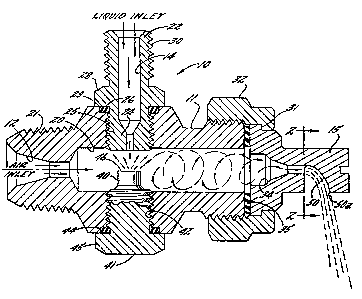Une partie des informations de ce site Web a été fournie par des sources externes. Le gouvernement du Canada n'assume aucune responsabilité concernant la précision, l'actualité ou la fiabilité des informations fournies par les sources externes. Les utilisateurs qui désirent employer cette information devraient consulter directement la source des informations. Le contenu fourni par les sources externes n'est pas assujetti aux exigences sur les langues officielles, la protection des renseignements personnels et l'accessibilité.
L'apparition de différences dans le texte et l'image des Revendications et de l'Abrégé dépend du moment auquel le document est publié. Les textes des Revendications et de l'Abrégé sont affichés :
| (12) Brevet: | (11) CA 1262751 |
|---|---|
| (21) Numéro de la demande: | 1262751 |
| (54) Titre français: | BUSE AVEC ASSISTANCE D'AIR, AVEC DISPOSITIF POSITIONNEUR DE DEFLECTEUR |
| (54) Titre anglais: | AIR ASSISTED NOZZLE WITH DEFLECTOR DIRECTING MEANS |
| Statut: | Périmé et au-delà du délai pour l’annulation |
| (51) Classification internationale des brevets (CIB): |
|
|---|---|
| (72) Inventeurs : |
|
| (73) Titulaires : |
|
| (71) Demandeurs : |
|
| (74) Agent: | MARKS & CLERK |
| (74) Co-agent: | |
| (45) Délivré: | 1989-11-07 |
| (22) Date de dépôt: | 1985-04-12 |
| Licence disponible: | S.O. |
| Cédé au domaine public: | S.O. |
| (25) Langue des documents déposés: | Anglais |
| Traité de coopération en matière de brevets (PCT): | Non |
|---|
| (30) Données de priorité de la demande: | ||||||
|---|---|---|---|---|---|---|
|
ABSTRACT OF THE DISCLOSURE
An air assisted spray nozzle having a nozzle
body formed with an elongated mixing and atomizing
chamber having an air inlet orifice communicating
with one end of the chamber, a liquid inlet orifice
communicating with a side of the chamber, and a
nozzle tip having a discharge orifice located at the
end of the chamber opposite the air inlet orifice.
Transversely directed streams of pressurized air and
liquid enter and converge in the mixing and
atomization chamber of the nozzle body causing
preliminary atomization of the liquid, which is
thereupon directed under the force of the high
velocity air stream out the discharge orifice and
against a deflector flange of the nozzle tip which
further atomizes the liquid and directs it into A
well-defined flat fan spray pattern with uniform
distribution and liquid particle size. To enhance
preliminary atomization, the mixing and atomizing
chamber has an inwardly extending liquid impingement
post in diametrically opposed relation to the liquid
inlet orifice, and to facilitate further atomization
and controlled direction of the discharging spray the
deflector flange defines an arcuate shaped guide
surface which is substantially wider than the width
of the discharge orifice and has a terminal lip
transversely offset from the discharge orifice.
Note : Les revendications sont présentées dans la langue officielle dans laquelle elles ont été soumises.
Note : Les descriptions sont présentées dans la langue officielle dans laquelle elles ont été soumises.

2024-08-01 : Dans le cadre de la transition vers les Brevets de nouvelle génération (BNG), la base de données sur les brevets canadiens (BDBC) contient désormais un Historique d'événement plus détaillé, qui reproduit le Journal des événements de notre nouvelle solution interne.
Veuillez noter que les événements débutant par « Inactive : » se réfèrent à des événements qui ne sont plus utilisés dans notre nouvelle solution interne.
Pour une meilleure compréhension de l'état de la demande ou brevet qui figure sur cette page, la rubrique Mise en garde , et les descriptions de Brevet , Historique d'événement , Taxes périodiques et Historique des paiements devraient être consultées.
| Description | Date |
|---|---|
| Inactive : CIB expirée | 2022-01-01 |
| Inactive : CIB expirée | 2022-01-01 |
| Inactive : CIB expirée | 2022-01-01 |
| Inactive : CIB expirée | 2022-01-01 |
| Inactive : Renversement de l'état périmé | 2012-12-05 |
| Le délai pour l'annulation est expiré | 2006-11-07 |
| Inactive : CIB de MCD | 2006-03-11 |
| Inactive : CIB de MCD | 2006-03-11 |
| Inactive : CIB de MCD | 2006-03-11 |
| Inactive : CIB de MCD | 2006-03-11 |
| Inactive : CIB de MCD | 2006-03-11 |
| Inactive : CIB de MCD | 2006-03-11 |
| Lettre envoyée | 2005-11-07 |
| Accordé par délivrance | 1989-11-07 |
Il n'y a pas d'historique d'abandonnement
| Type de taxes | Anniversaire | Échéance | Date payée |
|---|---|---|---|
| TM (catégorie 1, 8e anniv.) - générale | 1997-11-07 | 1997-10-17 | |
| TM (catégorie 1, 9e anniv.) - générale | 1998-11-09 | 1998-10-20 | |
| TM (catégorie 1, 10e anniv.) - générale | 1999-11-08 | 1999-10-18 | |
| TM (catégorie 1, 11e anniv.) - générale | 2000-11-07 | 2000-10-18 | |
| TM (catégorie 1, 12e anniv.) - générale | 2001-11-07 | 2001-10-17 | |
| TM (catégorie 1, 13e anniv.) - générale | 2002-11-07 | 2002-10-17 | |
| TM (catégorie 1, 14e anniv.) - générale | 2003-11-07 | 2003-10-16 | |
| TM (catégorie 1, 15e anniv.) - générale | 2004-11-08 | 2004-10-07 |
Les titulaires actuels et antérieures au dossier sont affichés en ordre alphabétique.
| Titulaires actuels au dossier |
|---|
| SPRAYING SYSTEMS CO. |
| Titulaires antérieures au dossier |
|---|
| JAMES HARUCH |